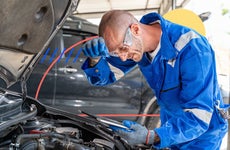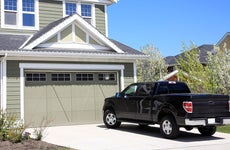Average cost of car maintenance: 2024 estimates

The Bankrate promise
At Bankrate we strive to help you make smarter financial decisions. While we adhere to strict , this post may contain references to products from our partners. Here's an explanation for .
Key takeaways
- The average cost to own and operate a new car in 2023 was $12,182.
- The average driver spends $2,299 per year for full coverage car insurance.
- Drivers of newer vehicles should get their oil changed every 5,000 to 7,500 miles.
- Over half (56 percent) of U.S. adults wouldn’t pay for an emergency expense of $1,000 or more, like a vehicle repair, from their savings account.
The price of vehicle ownership adds up. When the time comes to purchase your next car, you must consider the full cost of vehicle ownership — trips to the mechanic included. Though services range in cost, AAA found that drivers put an average of $12,182 toward their new cars in 2023. This is a $1,454 increase from the previous year.
With more expensive vehicle prices, it’s important to prepare for additional costs when budgeting for a car you can afford. Research the average annual costs of different vehicle types and brands to estimate how much a car will cost you over the course of ownership.
How much does vehicle maintenance cost?
Drivers in 2023 averaged 9.83 cents per mile driven on maintenance, repairs and tire replacement, according to AAA. That estimate assumes 15,000 miles driven per year. However, the total cost of vehicle maintenance will vary depending on a combination of factors.
Taking your car in for regular maintenance is an unavoidable expense that comes with vehicle ownership. And avoiding it won’t save you any money — it could even result in longer term issues for your car.
“The squeaky wheel gets the grease, or it should, anyway,” Mike Crossen, a Consumer Reports automotive technician, says. “If your car is leaking fluids or making an abnormal noise, get it checked out pronto. Timely action could save you a lot of money.”
Regular maintenance can help preserve your vehicle’s value, too. That benefits you if you want to trade in or refinance the vehicle.
Routine maintenance
Routine vehicle maintenance keeps your car running the way it should and, by extension, keeps you and your passengers safe. Maintenance costs vary by vehicle type, age and location, but there are some basics that almost every car needs.
Typically, your vehicle will need a visit to the mechanic for overall upkeep every 5,000 or so miles. But check your owner’s manual for specifics on your car’s needs.
While mechanics are there to help you, they also need to turn a profit. So, while most maintenance does require professional help, consider what you can handle at home to save money.
| Maintenance | Frequency | Expected cost |
|---|---|---|
| Oil change | Every 5,000 to 7,500 miles | $35 to $125 |
| Tire rotation | Every 5,000 to 8,000 miles | $60 to $72 |
| Brake pad replacement | Every 10,000 to 20,000 miles | $150 to $300 per axle |
Replacing vehicle parts
You will almost certainly have to replace some parts on your vehicle, either due to general wear-and-tear or larger issues. And the older your vehicle gets, the more of these costs you’ll encounter. This is an important factor to weigh when deciding between a new vs. a used car.
The replacement’s price tag depends on the part that needs replacing. Mechanics may not have the exact extra batteries, transmission or brakes your vehicle requires on hand, and delivery takes time. Outside of that, two common factors that influence cost are vehicle type — luxury vehicles carrying higher costs for parts — and the market cost.
If you’re comfortable working with vehicles, you could save money by replacing your air filter or wipers yourself.
| Vehicle part | Frequency | Expected cost |
|---|---|---|
| New tires | Every six years or 25,000 to 80,000 miles | $50 to $300 each |
| Air filter replacement (engine and cabin) | Every 15,000 to 30,000 miles | $40 to $100 |
| Wiper replacement | Every six months | $53 to $64 |
Unexpected repairs
Surprise costs are bound to come up in vehicle ownership. This could be an unexpected spill that stains the interior of your car or something more serious like a fender bender. Either way, it is important to have extra money saved in case unexpected repairs pop up.
The Bankrate Emergency Savings Report found that 56 percent of U.S adults wouldn’t pay for an emergency expense of $1,000 or more, like an unexpected repair, from their savings account. While these costs are mostly out of your control, you can save future stress by budgeting for that worst-case scenario.
It is also wise to shop around and find a repair shop with a good reputation and fair prices. Contact your insurance company and see what is covered before spending money on a repair. Here’s an outline of common repairs that may come up and the costs that are associated with them.
| Unexpected repair | Expected cost |
|---|---|
| Flat or blown tire | $20 to $100 |
| Transmission issue | $2,900 to $7,100 |
| Hail damage | $750 to $10,000 |
| Minor collisions | $150 to $2,000 |
| Engine overheating | $100 and $6,000 |
| Dead battery | $45 to $250 |
| Broken starter motor | $150 to $1,100 |
Maintenance cost by brand
The out-the-door price of a higher-end vehicle is higher than that of a standard car — and its maintenance will carry a higher cost, too. Your warranty may even require you to handle maintenance at a specific dealership, even for simple services like oil changes and mileage inspections. The dealer experience tends to be more expensive but ensures you’ll have a mechanic who specializes in your car’s make and model.
“If you are considering a luxury model, it may be wise to purchase one from a domestic brand that may have lower maintenance and repair costs,” says Steven Elek, Consumer Reports’ program leader for auto data analytics.
He points out that the 10-year cost of owning a Mercedes-Benz is more than double that of a domestic option, like a Lincoln. Consider expected vehicle costs by brands based on the 2023 Consumer Reports Annual Auto Survey.
| Vehicle brand | Cumulative 5-year maintenance costs |
|---|---|
| BMW | $1,700 |
| Chevrolet | $1,200 |
| Dodge | $1,200 |
| Ford | $1,100 |
| Honda | $1,435 |
| Kia | $1,450 |
| Mercedes | $2,850 |
| Nissan | $1,300 |
| Subaru | $1,700 |
| Toyota | $1,125 |
Cost by vehicle type
Although the brand of the vehicle clearly influences the cost of maintaining it, the type of vehicle is also a large determining factor. Larger vehicles are typically more costly to maintain. But there is no perfect recipe for finding an inexpensive car.
AAA found this cost by calculating the cost of depreciation, financing, fuel, insurance, licensing, registration, taxes, maintenance, repairs and tires across five years of ownership and 75,000 miles. The lowest cost for vehicle maintenance goes to small sedans, while the half-ton pickup is the most expensive.
| Vehicle type | Cost of ownership in cents per mile |
|---|---|
| Small sedan | 59.59¢/mile |
| Medium sedan | 73.65¢/mile |
| Subcompact SUV | 64.79¢/mile |
| Compact SUV | 67.10¢/mile |
| Medium SUV | 79.81¢/mile |
| Midsize pickup | 81.72¢/mile |
| Half-ton pickup | $1.06/mile |
| Hybrid | 64.33¢/mile |
| Electric | 67.41¢/mile |
How to keep repair costs low
While understanding typical vehicle upkeep costs can help you budget, the key to successful ownership is avoiding those trips altogether. Some costs are unavoidable, like oil changes and other routine maintenance, but certain vehicles require more attention than others. Consider ways to reduce maintenance costs.
- Don’t ignore dashboard indicators: Once a repair icon appears on your dashboard display, it is best to get it checked out sooner rather than later. The longer you put off the inevitable, the more likely you will have to spend more. And more important than cost alone, vehicle issues can compound and result in a dangerous driving experience.
- Buy the right car: Just as vehicle prices vary, so do the parts that make up the car. If you opt for a luxury option, you will likely be stuck with more expensive upkeep. Outside of the vehicle brand, research your purchase to confirm there aren’t any common issues owners have encountered.
- Compare maintenance costs: Don’t settle on the first vehicle shop you come across. Instead, call and inquire about the expected costs for the maintenance you plan on purchasing. Some places might even cut down costs if you source your own parts or are a long-standing customer.
The bottom line
Keeping your vehicle up to date on its maintenance is essential for safe driving and to make your car last. To save on another major cost, compare auto loan rates before buying to secure a manageable monthly payment.
Related Articles



